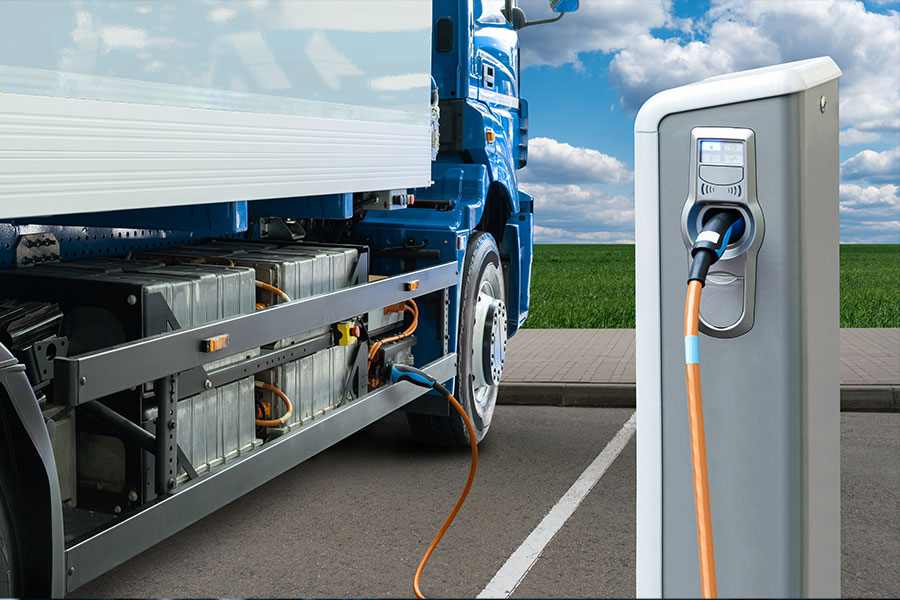The number of electric cars on the roads in Germany is increasing significantly. The "combustion engine ban" due to come into force from 2035 will also play a major role in increasing the share of electric cars. Even though the ban on combustion engines will not initially apply to heavy commercial vehicles: What are the current developments with this vehicle type? Electric lorries are already available, so are we also facing a major change in the transport sector? And what about the required infrastructure?
The focus is currently on two basic technologies, the fuel cell lorry, which runs on a hydrogen-powered fuel cell and the e-lorry, which runs on battery power. In short: Manufacturers are already offering electric lorries as an alternative to diesel engines.
Electric lorries and their ranges
In addition to the eActros Long Haul from Daimler Truck with a range of around 500 kilometres, the Dutch manufacturer Daf Trucks, Volvo and Renault are already offering corresponding counterparts. Other manufacturers are set to follow. MAN is planning its first long-distance electric lorry for 2024 and Scania has already presented the 45 R tractor unit, also with a planned range of 450 km in the highest possible battery configuration. In terms of range, all suppliers can already easily reach 300 to 400 kilometres, of course with a fully charged battery. According to the company's own data, the TESLA Semi can reportedly even reach nearly 500 miles (approx. 800 kilometres).
What is the current share of electric lorries and what are the forecasts here?
Demand is still very low, so the market is consequently growing at a very slow pace. In 2022, the market share of heavy electric lorries in Europe was just 0.3 percent, with lightweight and medium-weight electric lorries at 3 percent. In the same year, pure electric cars already reach a double-digit market share of almost 18 percent in Germany alone. But what are the reasons for this big difference?
High costs are the reason for lack of demand for electric lorries
While it may seem mundane, electric lorries are simply very expensive to buy, especially in long-distance transport, and so demand is low (at the moment). Daimler sold 914 light and heavy electric lorries with battery drive in 2022, even though Daimler had capacity for more. So there is clearly no shortage of availability! Another point that is slowing demand is the still inadequate charging infrastructure.
But that could soon change, as a CO2 levy of 200 euros per ton will be introduced to the lorry toll from 1 December, 2023. And this drastic toll increase could make electric lorries more attractive and economical. Especially because emission-free vehicles are initially exempt from the toll until the end of 2025 and are likely to be subject to a reduced toll after this date.
Another challenge is the ongoing lack of infrastructure
The available charging infrastructure is still inadequate for freight traffic. Two types of charging station are required to build a comprehensive, high-performance charging network specifically for commercial vehicles: charging stations that comply with the MCS standard (Megawatt Charging System) and NCS charging stations (Night Charging System). The latter are designed for charging at night and require a continuous charging capacity of 100 kilowatts. MCS charging stations, on the other hand, have to deliver a very high charging capacity, from 900 kilowatts to 4.5 megawatts, as these stations are intended for "short" intermediate charging, for example during the prescribed breaks for lorry drivers. Another challenge in this field is that a connection to the high-voltage network is required, especially for the MCS charging points.
Looking to the future
In summary, it can be said that developments have already advanced in the field of e-mobility in commercial vehicles. Although several suppliers already offer e-lorries, the market share is still low, which is mainly due to the high purchase costs and inadequate charging infrastructure. The introduction of a CO2 levy on lorry tolls could help to increase demand, however. There is also the challenge of building an adequate, high-performance charging infrastructure to meet the requirements of freight transport. Overall, there is great change ahead in the transport industry and the sector will increasingly have to embrace electric mobility in the coming years.

